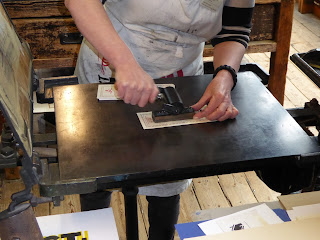On contacting the printing works to enquire about a visit we were told that although they do not open to the public on a Thursday, a group visit could be arranged for us. Twelve GIG members decided that this was an opportunity not to be missed! We were also pleased to stop in Hawick and pick up Keith and Margaret who were to join us for the day.
Robert Smail's Printing Works is a functional printing works in Innerleithen, now preserved by the National Trust for Scotland.
From the outside it looks just like a small shop...
... which it is, as a variety of commercial printing jobs are still produced today.
We were given a brief history of the firm - it was established in 1866, printing for the local community and operating as a stationer's shop. It later also published a weekly newspaper.
The Smail family remained the owners of the business until Cowan Smail retired and the National Trust acquired the property in 1986. It was opened to the public in 1990.
We were taken to the office and shown examples of the hoarding capacity of the Smail family. They kept every order, bill and receipt that came through the business! Bundles of paper-wrapped paperwork filled every shelf. We were shown examples of items printed - all kept in huge books called Guard books.
Photographs around the room show how little everything has changed over the years - the Smails' made little effort to keep up with technology. Their systems worked, so why change them? They were also agents for the White Star shipping line (of Titanic fame) and have records of every ticket they ever sold, who they sold them to, and where they were going!
Behind the shop front is another small building where the actual printing is done. Downstairs is a replica of the original water-wheel that powered the works. Upstairs is the case room, where typesetting took place. There are many racks of letters of different print types around the room, with those in use being on top of the cupboard.
Our guide showed us how to set type, by hand, into a metal composing stick. We paid close attention at this point as we were going to set the type for our names! After a lot of thought, and help where necessary, we all succeeded in setting our type before our guide used a hand-operated printing press to make a book mark for each of us.
We were taken to see the larger printing presses used for bigger jobs, and the most up to date press, the Heidelberg Press, bought in 1952.
As we toured the building we were told by our experienced and very knowledgeable guides much interesting information, including some of the well known phrases we use today that actually derive from printing terms. Dab hand, Upper and Lower Case, Mind your P's and Q's, Not the Full Shilling, Make a Good Impression and Out of Sorts all come from printing origins.
Mind your P's and Q's was advice given to apprentices - as it is easy to confuse the mirror images of the p and q type. Originally it therefore meant be careful with your work!
Upper and lower case comes from the practice of separating capital and small letters into different cases. When required for setting , the cases were put out on the rack with the capitals on the upper part and the small letters on the lower - hence upper and lower case letters.
Robert Smail's printing works is a treasure and the National Trust for Scotland is doing a grand job keeping it alive and flourishing. They still have much work to do cataloguing and cross referencing all the information that is stored in the building - but will surely get there eventually!
For anyone who finds themselves anywhere near Innerleithen, it is well worth a visit!









No comments:
Post a Comment